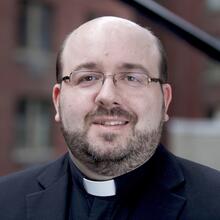The synod did not turn out exactly the way anyone expected. Thanks be to God.
Due to some good luck in scheduling, I was in Rome for the conclusion of the first general assembly of the Synod on Synodality, at the end of October. We had just finished an America Media pilgrimage to Assisi and Rome, spending time reflecting on the spirituality of both St. Francis and St. Ignatius and how they have informed the ministry of Pope Francis.
And because my brother Jesuit, Father James Martin, is a member of the synod, I had been given a ticket inviting me to concelebrate at the final Mass of the synod assembly in St. Peter’s Basilica. The members of the synod—laypeople, religious, priests and bishops—were seated centrally in the basilica. My ticket, however, directed me to appear an extra hour early at the Gregorian Chapel inside the basilica to get vested for Mass; I assumed I would be seated far off to the side, probably behind a pillar.
After we were vested, one of the masters of ceremonies appeared, and it was only then I learned that I would be pressed into service to distribute Communion.
It was not my first time concelebrating a papal Mass (I had been in the crowd of priests at Madison Square Garden when Francis visited New York in 2015), but it was my first time doing so inside St. Peter’s. Getting to the Gregorian Chapel was the first challenge. The security line for the basilica moved quickly enough, and showing the yellow concelebration ticket to the Vatican police officers got us ushered ahead smoothly, until it didn’t. Along with a Jesuit deacon who was also serving at the Mass, I had been following a bishop until the Swiss Guards waved him through the door to the right of the main entrance and told us we had to exit the square entirely and circle around to a different gate.
Instead, we went back to the main entrance with the crowd, and then I got waved through to the vesting area while the deacon got directed to the other side of the basilica. He wound up 10 minutes later in the same vesting area I was in, having been bounced through another couple of rounds of showing his ticket to various guards.
After we were vested, one of the masters of ceremonies appeared, and it was only then I learned that I would be pressed into service to distribute Communion. The M.C. gave us instructions in Italian, about one quarter of which I could understand with the help of very rudimentary Spanish. But they’re used to that in Rome; the elegant pantomime accompanying the very slow and clear Italian did most of the work. I ended up seated in a semicircle behind Bernini’s beautiful baldacchino, and then standing about 20 feet from the main altar during the eucharistic prayer. It was a powerful and consoling experience of praying as part of the universal church.
The reason I tell this long story about winding up a stone’s throw from the altar over the tomb of Peter is that I have realized, in the days following the synod’s meeting, that not entirely knowing where to go and being surprised by what happens when you get there seems to be part of what happened in the synod itself. You will see this reflected, I think, both in the interview with Cardinal Cupich and in the Synod Diaries featured in this issue of the magazine.
Not entirely knowing where to go and being surprised by what happens when you get there seems to be part of what happened in the synod itself.
In anticipation of the October meeting, there was both hope and fear that some fundamental shift on a topic like ordination of women to the diaconate or blessings of same-sex unions would be decided. In the end, neither the commentators who speculated hopefully about an immediate change in church teaching nor those who argued for such a change to be definitively precluded found vindication.
These topics were certainly both discussed, but instead of a final decision, the synod’s synthesis document instead affirmed the importance of ecclesial reflection on the “original interweaving love and truth flowing from Christological revelation,” noted that the members of the synod had a range of views and experiences of these topics, and called for further and deeper discussion. Other ideas in the synthesis document, such as a recommendation of performance reviews for bishops and a call to consider making pastoral councils mandatory, were not the focus of either anticipation or dread, but may have a more significant impact on the church in the near term.
Some commentators may say that calling for ongoing discussion of neuralgic topics is simply a stalking horse for eventual change. I think, however, that they may be missing the real action of the Spirit while focusing on preserving the truth of church teaching from possible distortion.
There is something to learn from the fact that discussion on the most difficult topics was neither rushed to a conclusion nor closed absolutely. The dialogue and listening that the synod process continues to put at the center may be more like my ticket to concelebrate than any defined agenda, pre-arranged plan or clear scheme for decision making. Its point is not to tell us exactly what we are going to be doing, but to get us through the door together, so that we can be put to work serving God’s people.







